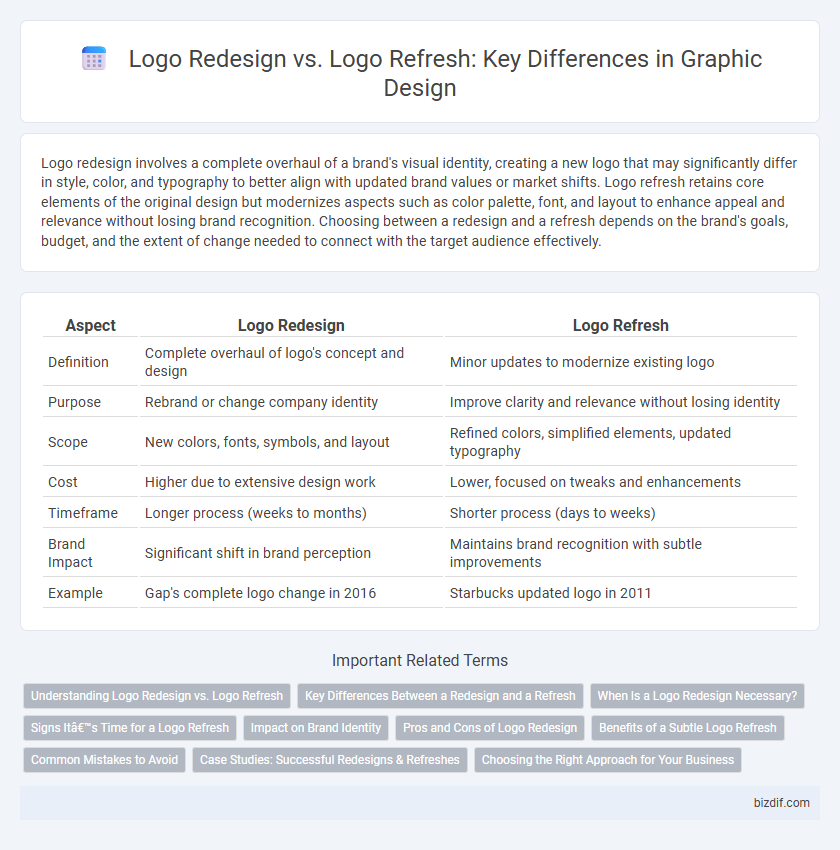Logo redesign involves a complete overhaul of a brand's visual identity, creating a new logo that may significantly differ in style, color, and typography to better align with updated brand values or market shifts. Logo refresh retains core elements of the original design but modernizes aspects such as color palette, font, and layout to enhance appeal and relevance without losing brand recognition. Choosing between a redesign and a refresh depends on the brand's goals, budget, and the extent of change needed to connect with the target audience effectively.
Table of Comparison
| Aspect | Logo Redesign | Logo Refresh |
|---|---|---|
| Definition | Complete overhaul of logo's concept and design | Minor updates to modernize existing logo |
| Purpose | Rebrand or change company identity | Improve clarity and relevance without losing identity |
| Scope | New colors, fonts, symbols, and layout | Refined colors, simplified elements, updated typography |
| Cost | Higher due to extensive design work | Lower, focused on tweaks and enhancements |
| Timeframe | Longer process (weeks to months) | Shorter process (days to weeks) |
| Brand Impact | Significant shift in brand perception | Maintains brand recognition with subtle improvements |
| Example | Gap's complete logo change in 2016 | Starbucks updated logo in 2011 |
Understanding Logo Redesign vs. Logo Refresh
Logo redesign involves a complete overhaul of a brand's visual identity, including new colors, typography, and iconography to redefine the brand's message and appeal. Logo refresh updates existing brand elements subtly, maintaining core recognition while modernizing the design with minor adjustments to color, font, or layout. Understanding this distinction helps businesses decide between preserving brand equity or reinventing their market presence through strategic graphic design.
Key Differences Between a Redesign and a Refresh
A logo redesign involves a complete overhaul of the logo's visual identity, including changes to the design elements, typography, and color palette to establish a new brand direction. In contrast, a logo refresh updates existing design components, subtly modernizing the logo without altering its core identity or recognizability. Key differences lie in the scope and impact, with redesigns targeting significant brand repositioning while refreshes aim to enhance brand consistency and contemporary appeal.
When Is a Logo Redesign Necessary?
A logo redesign is necessary when the current logo no longer aligns with the brand's core values, target audience, or market positioning, often due to major business changes or outdated aesthetics. Significant shifts such as mergers, rebranding, or a drastic change in product offerings typically require a complete overhaul rather than a simple refresh. Brands aiming to improve recognition and relevance in competitive markets must evaluate these factors to determine if a full logo redesign is essential.
Signs It’s Time for a Logo Refresh
A logo refresh involves subtle updates to modernize the design while maintaining brand recognition, such as adjusting colors, fonts, or simplifying elements. Signs it's time for a logo refresh include outdated style, poor scalability across digital platforms, and evolving brand identity that no longer aligns with the original logo. Companies aiming to stay relevant and visually appealing often choose refreshes over complete redesigns to preserve customer loyalty while enhancing their brand image.
Impact on Brand Identity
Logo redesign involves creating a completely new visual representation that can significantly alter brand identity, often signaling a strategic shift or modernization effort. Logo refresh updates existing elements like color, font, or style to enhance brand recognition while maintaining core identity, preserving customer loyalty and consistency. Brands must weigh the impact on brand equity, as redesigns can risk alienating existing audiences, whereas refreshes typically strengthen familiarity and trust.
Pros and Cons of Logo Redesign
Logo redesign offers the advantage of completely transforming a brand's identity, enabling businesses to better align with current market trends and target audiences, which can lead to increased brand recognition and customer engagement. However, it involves higher costs, longer timelines, and risks alienating existing customers who are familiar with the original logo. While a redesign can revitalize a brand's image, it requires careful strategic planning to balance innovation with brand heritage.
Benefits of a Subtle Logo Refresh
A subtle logo refresh enhances brand recognition by modernizing design elements while maintaining core identity, ensuring customer loyalty remains intact. It improves visual appeal and adaptability across digital platforms without alienating existing audiences. This approach reduces costs and minimizes risk compared to a complete logo redesign, delivering efficient brand evolution.
Common Mistakes to Avoid
Confusing a logo refresh with a complete redesign often leads to losing brand recognition or failing to modernize effectively. Avoid neglecting audience feedback during update decisions, as this can result in a logo that no longer resonates with core customers. Overcomplicating the design or drastically altering key elements such as color schemes and typography are common mistakes that diminish brand consistency.
Case Studies: Successful Redesigns & Refreshes
Case studies of successful logo redesigns, such as Airbnb's transformation in 2014, demonstrate a complete brand evolution with new typography, iconography, and color schemes that revitalized global recognition. Logo refresh examples like Coca-Cola's subtle typographic updates maintain brand continuity while modernizing the look to appeal to contemporary audiences. Analyzing these case studies highlights how strategic redesigns drive stronger brand identity and how refreshes optimize legacy designs for current market trends.
Choosing the Right Approach for Your Business
Logo redesign involves creating a completely new visual identity, ideal for businesses undergoing significant changes or targeting a new audience, while logo refresh updates existing design elements to modernize and improve brand recognition without losing established equity. Choosing the right approach depends on factors like the extent of brand evolution, market positioning, and customer perception, ensuring the design aligns with current business goals. A strategic refresh preserves brand continuity and is cost-effective, whereas a redesign offers a bold transformation to revitalize a stagnant or outdated image.
Logo redesign vs Logo refresh Infographic

 bizdif.com
bizdif.com